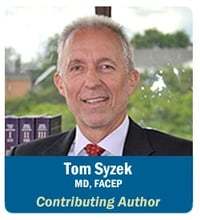 Not all chest pain is a heart attack. While acute coronary syndrome (ACS) may be the most common serious cause of chest pain, clinicians must keep other dangerous conditions in the differential diagnosis and eliminate the possibilities based on the patient’s history, risk stratification, physical exam and diagnostic testing. One of the most dramatic and perplexing causes for acute chest pain, other than ACS, is thoracic aortic dissection.
Not all chest pain is a heart attack. While acute coronary syndrome (ACS) may be the most common serious cause of chest pain, clinicians must keep other dangerous conditions in the differential diagnosis and eliminate the possibilities based on the patient’s history, risk stratification, physical exam and diagnostic testing. One of the most dramatic and perplexing causes for acute chest pain, other than ACS, is thoracic aortic dissection.
Thoracic aortic dissection (TAD) is a Great Masquerader. It can present with symptoms extending from head to toe and can mimic ACS, TIA or stroke, back strain, abdominal catastrophes and extremity conditions. TAD is an actor that likes to travel; it may first afflict the patient with chest pain that abates, only to reappear in the neck, back, abdomen or extremities. It is a sneaky character that can confound even the most astute clinician as the patient continues to have acute chest pain despite normal diagnostics, including ECG, chest X-ray and troponins. Sometimes the diagnosis of TAD is completely masked and simply cannot be made. Aortic disease is one of the most difficult of all medical diagnoses.
Each year in the U.S., there are about 25,000 cases of TAD, making it 2-3 times more common than ruptured abdominal aortic aneurysm but much less common than ACS or pulmonary embolism. Unfortunately, the diagnosis is unsuspected and delayed in more than 1/3 of patients with TAD, and the outcome in undiagnosed/untreated patients is often fatal. Although the biggest risk for clinicians is the delay or failure to diagnose TAD, delays in appropriate treatment also pose a threat to patient safety.
 TAD, however, is not a perfect criminal and very often leaves clues to its existence. It is up to the practitioner to be a shrewd detective with an open mind and avoid the common cognitive errors of anchoring or premature closure. Symptoms of TAD are often erroneously attributed to other more common conditions, even when all the pieces of the puzzle do not perfectly fit. The detective clinician should maintain suspicion for TAD when evaluating the patient with any of the following:
TAD, however, is not a perfect criminal and very often leaves clues to its existence. It is up to the practitioner to be a shrewd detective with an open mind and avoid the common cognitive errors of anchoring or premature closure. Symptoms of TAD are often erroneously attributed to other more common conditions, even when all the pieces of the puzzle do not perfectly fit. The detective clinician should maintain suspicion for TAD when evaluating the patient with any of the following:
- Abrupt onset of severe pain in the chest, back or abdomen; described as ripping, tearing, sharp or stabbing.
- Significant chest pain continues despite normal ECG and troponins.
- Symptoms change over space and time – migrate, radiate, or come and go.
- Multiple organ systems are involved: cardiac, neurologic, abdominal, renal, peripheral circulation.
Risk factor analysis can reveal important clues to the diagnosis, but clinicians often simply do not assess for TAD risk factors. There are several high-risk conditions, pain features, and exam features that are part of the “Aortic Disease Detection Score” that should be considered in the evaluation of patients with any of the clinical presentations outlined above. These risk features include:
- High-risk conditions: hypertension, Marfan Syndrome, connective tissue disease, family history of aortic disease or unexplained sudden death, aortic valve disease, recent aortic manipulation, known thoracic aortic aneurysm
- High-risk pain features: chest, back or abdominal pain that is abrupt or severe AND described as ripping, tearing, sharp or stabbing
- High-risk exam features: pulse deficit, systolic BP differential, focal neurologic deficit in conjunction with pain, new murmur of aortic insufficiency, hypotension or shock state
Confronted with seemingly unconnected and inexplicable signs and symptoms, clinicians are sometimes left in a quandary regarding the appropriate diagnostic workup. The ECG and troponins are usually normal, and the chest X-ray is often abnormal but non-specific. The definitive diagnosis is made by advanced imaging (CTA of thoracic aorta, MRI, or TEE), which is recommended in all patients stratified as high-risk and in intermediate and low-risk patients when TAD remains in the differential diagnosis.
Comprehensive guidelines for the diagnosis and management of patients with TAD were published in 2010; these are a must-read. With a mortality rate of 1% to 2% per hour for the first 24 to 28 hours, TAD qualifies as a “seconds-to-minutes” emergency that demands super-STAT evaluation and treatment. But first, clinicians must remember that not all chest pain is a heart attack and keep the Great Masquerader in mind.
Interested in learning more for CME?
Review our courses:
- Thoracic Aortic Dissection in Emergency Medicine
- Thoracic Aortic Dissection & Marfan Syndrome
- Thoracic Aortic Dissection Case Studies
- Thoracic Aortic Dissection in Hospital Medicine - Hospitalist
Additional Resources & Links
American Heart Association. www.heart.org
Hiratzka LF, et al. 2010 ACCF/AHA/AATS/ACR/ASA/SCAI/SIR/STS/SVM guidelines for the diagnosis and management of patients with thoracic aortic disease. Circulation. 2010;121(13):e266-e369.
The Thoracic Aortic Disease (TAD) Coalition is a group of organizations and individuals who share a common mission of preventing premature deaths due to thoracic aortic aneurysm and dissection. www.tadcoalition.org
The John Ritter Foundation for Aortic Health. www.johnritterfoundation.org
The Marfan Foundation www.marfan.org


